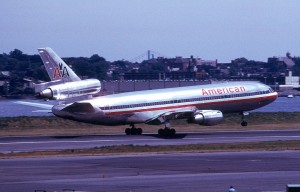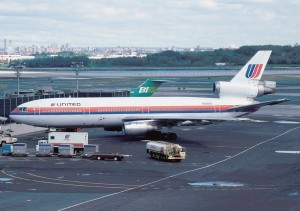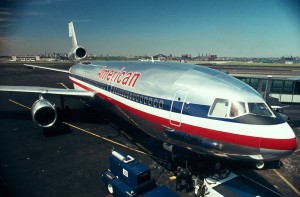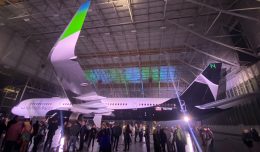The NYCAviation.com domain name was purchased in the Spring of 2003. That year saw the birth of our message boards, a listing of short news events, and our first article that September. In terms of age, this article is almost the biggest “#ThrowbackThursday” possible for us, being the third-ever to appear on our site over a decade ago. First published on January 4th of 2004, it epitomizes our roots of aviation enthusiast content. Reading this today is just as interesting to me as it was then. So when we say we have been doing this for a decade, we mean it. – Phil Derner, Founder
One usually associates trijets, excluding the 727, with ‘heavies.’ On the contrary, “heavies” are seldom associated with La Guardia. Nowadays, during a complete day of spotting at LGA, an aircraft weighing in at 255,000 pounds seems to be a privilege more than anything else. But, as photographers like Howard Chaloner and Art Brett dig deeper into their archives, we are reminded of an age where the McDonnell Douglas DC-10 and Lockheed L-1011 TriStar were the pride and joy of LGA.
Lockheed’s L-1011 TriStar and McDonnell Douglas’ DC-10 were initially conceived and designed to compete with each other, but ultimately complimented each other as two of the most unique aircraft to grace the skies. While the rest of the world was covered in a cloud of smoke, concerned with access to Studio 54 and psychedelic tie-die T-shirts, American Airlines was on the hunt for a high capacity, medium range airliner.
Both industrial giants, McDonnell Douglas and Lockheed jumped at this opportunity, and started development in much the same way. The two teams originally designed a twin-engine wide body, but research concluded that such an aircraft would not be able to meet existing power requirements with then-present engine technology. With this, the characteristic third engine was developed. Even with the added power, though, some were concerned about the DC-10’s and L-1011’s performance at an airport like La Guardia. Art Brett commented that he remembered seeing the DC-10, and thinking that it was too big for LGA. “Having flow in and out of LGA many times on different aircraft” says Mr. Brett, “I really wondered what the performance [would be like], but there was never a problem.” 7,000-foot runways and weight were just some of the limits to be taken into consideration. However, after all was said and done, these aircraft were a frequent visitor to LGA.
The ceremonial first flights of these aircraft occurred within months of each other, however, the DC-10 was flown by an airline nearly a year before its Lockheed competitor. Rolls Royce, the TriStar’s selected engine supplier, announced bankruptcy in the midst of developing the RB211, severely delaying the L-1011’s progress. Financial issues were eventually resolved, and the RB211 proved to be reliable and efficient. Lockheed’s trijet variant entered service with TWA and Eastern in 1972, a considerable amount of time after American Airlines introduced the first DC-10 into their fleet in 1971.
American scheduled services to LGA with the newest additions to their fleet almost immediately after their delivery in 1971. According to Mr. Brett, “The (inaugural flight) was delayed, because a passenger inadvertently deployed the emergency chute. Shortly thereafter, a mechanic left some tools in the intake of an engine, then did an engine runup.” These accidents did not hinder future activities, as over the next five years, United and National Airlines brought their Douglas DC-10’s to La Guardia, followed by Delta, Eastern and TWA’s Lockheed L-1011’s. By the mid 1970’s, La Guardia was catering to both of these wide bodies.
Right from the beginning, this was beneficial for La Guardia. In simple business terms, bigger equals better. These higher capacity aircraft filled LGA to the brim with the flying public, while collecting higher landing fees from the airlines. Passenger numbers increased nearly five-fold from 1960 to 1980, while the number of actual plane movements increased by only one-third.
LGA Passenger and Aircraft Movements
(year: pax/movements)
1960: 4,227,755/191,736
1970: 11,845,141/297,652
1980: 17,467,962/317,633
To the millions of untrained eyes, however, the airplane they flew in was nothing more than just that; an airplane. The building they just walked through was nothing more than just a building. End of story. However, Howard Chaloner recalls one of the most memorable times of his life being at the airport. “My first visit to LGA was in December 1976, shortly after our family moved to the USA from Tokyo,” he remembers. “Armed with my trusted Asahi Pentax Spotmatic F and Tamron 70-210 zoom lens, I was fortunate to be able to photograph many US domestic carriers aircraft over the next several years.” He goes on to say, “The observation deck at LGA was arguably one of the best locations in the world, offering panoramic views of all the gates at the main terminal. Arrivals and departures from both runways could be easily monitored. And, it only cost ten cents!” Although a rooftop viewing deck is no longer available, there is, at no charge, a viewing area before the security checkpoint complimented by rocking chairs. This helps LGA maintain its reputation for being one of the most unique airports of the past, present, and future. [Note: The rocking chairs have since been replaced by common airport seating]
Both aircraft ultimately spawned into different variants. Douglas developed the original DC-10-10, followed by the -30 and -40, and Lockheed produced the -100, -200, and -500, as well as conversion models like the -150 and -250 to follow the L-1011-1 base model. However, only the DC-10-10, and L-1011-1 were active at LGA.
Nowadays, quantity has given way to frequency, as is evident by the hundreds of small flights that now bombard La Guardia. The massive three-holers, specifically American’s DC-10-10s were often used on flights of a few hundred, to a few thousand miles.
These large jets were seen as AA563/1170 ferried passengers to/from Raleigh/Durham, NC (RDU) from LGA, a mere 375nm. AA068 was an even shorter hop from LGA to Buffalo, NY (BUF), a 250nm flight that is today flown by American Eagle ERJs and US Airways Express Dash-8s. Initially, though, American’s DC-10 flights were destined for either Chicago (ORD) or Dallas (DFW).
Eastern and Delta deployed their L-1011-1’s in a constant stream to Boston (BOS), only 160nm away, in addition to Atlanta (ATL), Ft. Lauderdale (FLL), Miami (MIA), Orlando (MCO), West Palm Beach (PBI) and Washington, D.C. (IAD).
Delta also continued sending their trijets to La Guardia for return trips to places like Atlanta (ATL) through the mid 90’s, and TWA provided runs to Kansas City (MCI) and St. Louis (STL)-which occasionally continued on to Phoenix (PHX).
Chicago (ORD) was also served by United’s DC-10-10s, which were also routed to Denver (DEN) on occasion. National Airlines and their own Douglas equipment provided more Florida destinations, like Miami (MIA) and Orlando (MCO).
You’re flying to London, and the six hours in an economy seat are the worst in your life. The lady in front of you is snoring with a crying baby in her arms, while the guy next to you took off his shoes to reveal his fungus infection. Art Brett and Clark Palicka experienced somewhat different conditions on their trijet flights, albeit an experience. Clark Palicka was a passenger on board a Delta L-1011-1 in 1996. “[The take off] was loud, and the plane shook a lot,” as he hurtled down the runway at La Guardia on his way to Atlanta. Art Brett details a less enjoyable flight. “One of the worst rides I’ve ever had was an EA L-1011 from BOS to LGA. We hit turbulence and must have dropped like a rock for several thousand feet. This guy had just gone into the potty and when he came out he had water splashed all over him.” Hopefully his shirt was blue.

Delta Air Lines L-1011 rolling out after landing on runway 31. Note the bi-centennial widget, which was applied to the Delta fleet during the USA’s 200th birthday celebration in 1976. (Photo by Howard Chaloner)
Air Canada’s ‘Horizons Enfance’, Comair’s 25th Anniversary, and Delta’s Olympic Spirit liveries and special decals have all made their appearance at La Guardia. Some of the first to bear out-of-the-norm colors were the trijets. The L-1011’s arrived just five years before the country’s bi-centennial, and for this occasion, several commemorative decorations on behalf of the airlines were evident. “Both Delta and Eastern applied special colors to their fleet to celebrate the bi-centennial in 1976” states Mr. Chaloner. “Delta applied a modified “widget”, with appropriate stars & stripes and the inscription ‘We the people…1776 – 1976’, whereas Eastern applied decals to the forward fuselage showing the evolution of the US flag with the wording ‘1776 – …what so proudly we hail – 1976’.”
Also, National Airlines used aircraft as a means to promote their ‘Fly Me’ campaign. By naming their fleet after women, National hoped to attract more customers. “I remember the National DC-10’s with the girl’s names on them. They were a hit,” adds Art Brett. “I caught Geraldine there one day, and was happy about that.” However, the Woman’s Liberation movement was not as appreciative of this, and deemed it to be degrading to women.

National DC-10 parked at the gate. Instagram has yet to respond to our inquiry if this photo inspired the “1977” filter. (Photo by Howard Chaloner)
La Guardia, up until this point in time, was accustomed to servicing much smaller jets and props. Jetways, as we know them, were yet to be installed. ‘Air stairs’ were the means by which passengers entered and disembarked the aircraft, be it in an old L-188 Electra or a new L-1011 TriStar. Until the advent of widespread commercial jet travel, and the elimination of slow, insufficient propeller travel, air stairs were the way to go. Up, or down.
Since the deregulation of airlines in 1978 resulted in smaller, cheaper airlines, the DC-10-10 and L-1011-1 have slowly been pulled from the limelight. New York Air DC-9s, Air Florida 737-200s, Midway F100s, and the like began to occupy La Guardia. The grandeur of LGA, however, was still there. The wide bodies were to be seen over the next 15 years, until Delta was one of the last to remain at LGA with their L-1011-1s.
These big boys had quite an extensive reign over northern Queens. For nearly 25 years, the TriStar and its Douglas counterpart soared over Planeview Park, ‘The Dock’, Rikers Island, and the East river. From the early 1970’s through the mid 1990’s, La Guardia truly was a ‘home to the heavies’.
Though 16 years old at the time of writing this, Brian Futterman has grown up and become a talented domestic airline First Officer that almost failed high school chemistry because La Guardia arrivals passed right by his classroom window.












